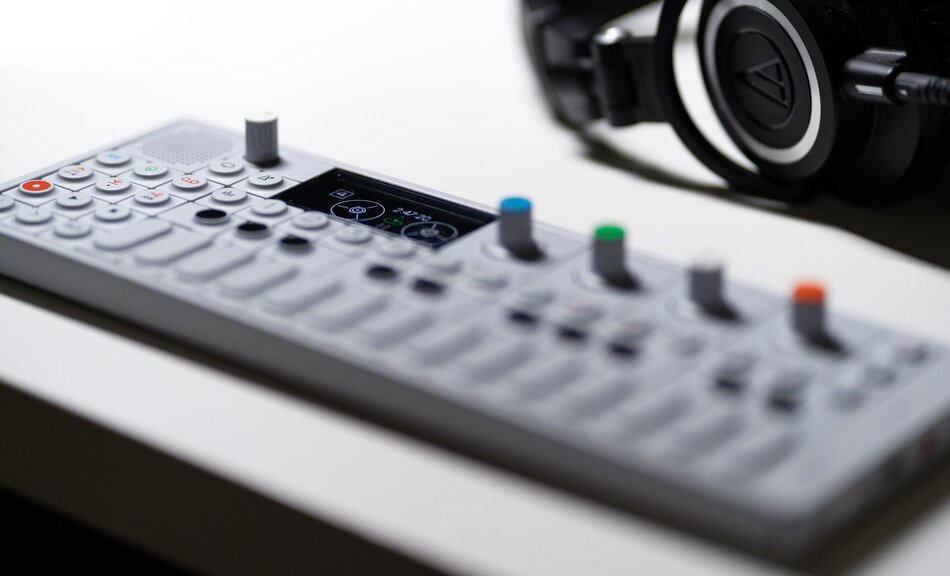
There are not many synthesizers out there with built-in speakers, and that’s totally understandable. It’s challenging to fit decent speakers in a synth’s form factor.
However, there are quite a number of synths out there with built-in speakers. Most of them are made for musicians who simply want to take their synths along and jam on the road, at the park, or want to have fun tweaking and playing sounds on their couch.
So, in this article, I’ll review five of the best synthesizers with built-in speakers. Featured in this review are some budget option synthesizers and some high-end synthesizers packed with a lot of features, all with a built-in speaker.
In a hurry? Here are my top picks:
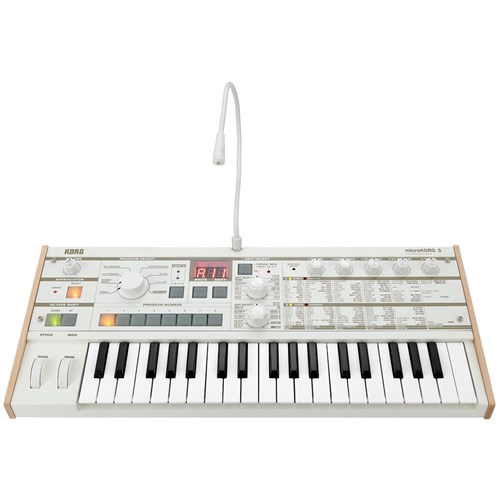
Korg MicroKorg S
My no. 1 pick in this list is the Korg MicroKORG S — very portable with a built-in vocoder, great-sounding onboard presets, and slots to save your custom patches. And the speakers are much better than most of the synths on this list.

Roland Jupiter Xm
My no. 2 pick is the Roland Jupiter Xm if you have some extra cash to spend. This is a digital synth suitable for the studio and for live performance, 1000’s of presets to choose from, and very easy to tweak and edit sounds.
Table of Contents
Quick Summary
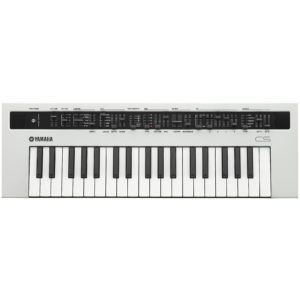
Yamaha Reface CS
- Can fit in a backpack
- Very tweakable synth
- 8-note polyphony
- Looper feature for making quick ideas
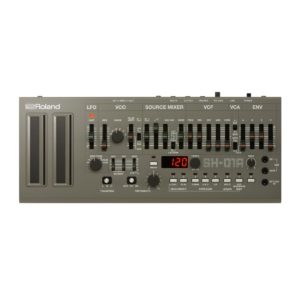
Roland SH-01A
- You can save patches and sequencer presets
- Built-in sequencer/arpeggiator
- Sub-oscillator for more low-end

Korg MicroKORG S
- Built-in subwoofer beefs up the sound
- 64 free slots to save sounds
- Built-in Vocoder
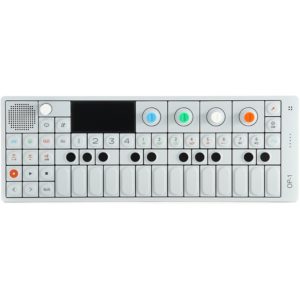
Teenage Engineering OP-1
- 10 Synth Engines
- Four-track tape recorder to get your ideas out fast
- Unique sequencer and arpeggiator modes
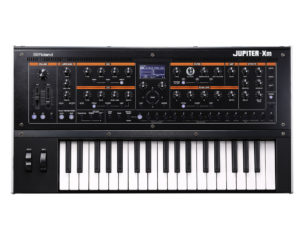
Roland Jupiter Xm
- Up to 9 synth and drum machine engines
- Bluetooth-enabled
- Very intuitive and easy to use
3 Things to Consider when Buying a Synthesizer with Built-In Speakers
1. Speaker Quality
Manufacturers usually don’t consider putting speakers inside synthesizers for many reasons, which I covered in detail in this article. In essence, the size of synthesizers makes it difficult to fit better sounding speakers.
For this reason, the speakers in most synths are not that great. But obviously, some manufacturers put a little bit of effort into making sure the speakers are much enjoyable. And if you are really keen on having excellent built-in speakers, you should consider the speakers’ quality.
However, most speakers inside synthesizers are good for referencing what you are playing, and you won’t get an accurate representation of the sound.
2. Portability/Weight
You are probably looking for a synth with a speaker because you want to be able to take it anywhere and play. If that’s the case, then you need to consider how portable the synth is. Can it fit in a backpack? Is it easy to carry along? These are some of the questions you need to ask when choosing a synth.
3. Budget
How much are you willing to spend on the synth? I think this is an important question, and the answer will vary based on your goals.
Are you a hobbyist looking for a fun synth to play with? Or are you a professional musician looking for a well-built synthesizer with lots of features? I think these different scenarios should give you an idea of how much you should be willing to spend.
For professionals, a well-built synthesizer that can be used for live performance and in the studio and still be relevant for years to come is key. So spending that extra cash on a very good synthesizer is a no-brainer.
However, for most beginners and hobbyists, something in the lower-price range should be good enough for you. However, if you have the money to spend on an excellent synth, go for it.
The 5 Best Synthesizers with Built-in Speakers
1. Yamaha Reface CS

Yamaha’s Reface series is an attempt by the company to put all of their legendary synthesizers and sounds into a compact synth that can be carried along anywhere you go. And they did an excellent job making these. There are four compact keyboards in this series — the YC, DX, CP, and CS.
The Yamaha Reface CS is a compact analog modeling synthesizer in the reface series with excellent sonic capabilities. If you own any of the Yamaha CS synthesizers, the reface CS will be a walk in the park. Nonetheless, it’s a very straightforward synthesizer that is effortless to use.
The reface CS has a single oscillator with five different types of waveforms to choose from. You also get a single LFO, a filter cutoff and resonance, and an ADSR envelope for controlling the amplitude and filter.
There is also an effect section with five effects to play with — Distortion, Chorus, Flanger, Phaser, and Delay.
This is an 8-note polyphonic synth, meaning you can play up to eight notes simultaneously. However, you can switch it to the monophonic mode and play one note at a time. This is excellent for playing bass and lead sounds.
One feature that makes the Reface CS much more enjoyable and fun to play, in my opinion, is the Looper. This feature allows you to record and overdub MIDI. You can tweak the tone while the loop plays back, add effects, or jam along.
Now let’s talk about the Yamaha Reface CS’ built-in speakers. As I mentioned earlier, it’s difficult to fit a decent speaker in a synthesizer, and the speakers inside the Yamaha Reface CS is no exception. There are two speakers installed on the top left and right corners of the synth, and the speakers are 30mm in size.
As you may have already guessed, these are not full-range speakers. This means you won’t get an accurate representation of your synth’s sound. However, the speakers are great for referencing your synth patch and making ideas without the need to connect to an external speaker or headphone. However, there is a headphone jack and a stereo line output jack to connect to a studio monitor, audio interface, DI Box, or headphones.
If you are into FM synthesis, then an alternative to the Reface CS you’ll love is the Yamaha Reface DX (also on Amazon). It’s an emulation of the classic Yamaha DX, one of the most iconic synths of all time. All of the Reface keyboards from Yamaha can be powered by 6AA batteries, just in case you want to take it along to the park or a trip.
Pros
- Can fit in a backpack
- No menu-diving — very tweakable synth
- 8-note polyphony allows you to play extended chords
- The Looper is an excellent feature for making ideas and having fun
- 5 Effects gives you more ways to create a unique sound
Cons
- No presets
- Patches can’t be saved
- You need to have basic knowledge of sound design
Bottom Line
Overall, the Yamaha Reface CS is an ideal synth for beginners who want to learn sound design. Although you can’t save your patches, which is a con, it will force you to create your own sounds from scratch every time. And that will help you improve your sound design skill.
Also, it’s an excellent piece of gear to have fun with anywhere as a musician.
2. Roland SH-01A
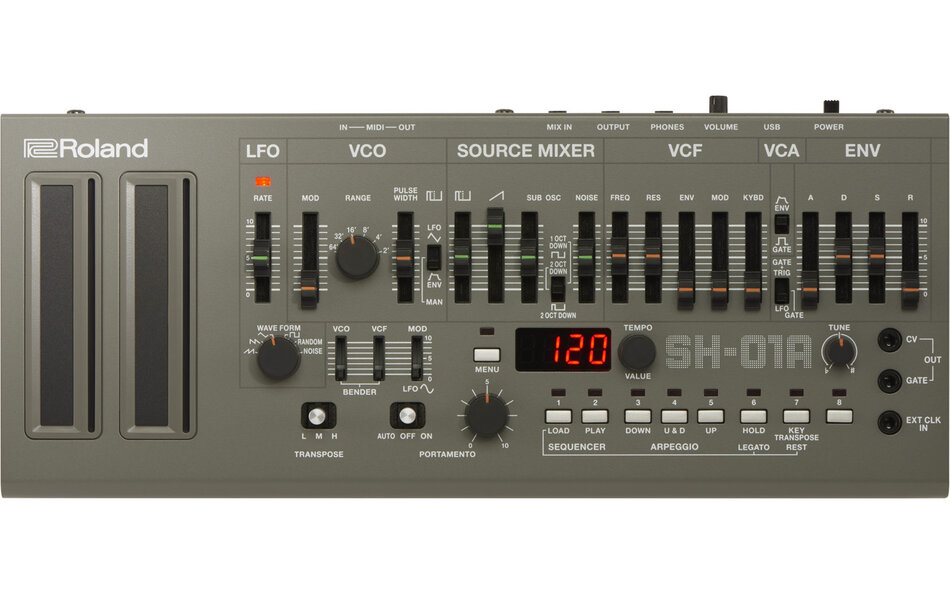
I’m sure you have heard of the Roland Boutique synthesizers by now. These synthesizers are the best emulations of Roland’s classic synthesizers, and the Roland SH-01A is one of the Roland boutique lineups with a built-in speaker.
Roland’s SH-01A was inspired by the classic Roland SH-101 analog synthesizer, which is a monophonic synth. Although the new SH-01A is a digital synthesizer, it sounds very identical to the original SH-101, and you will not even notice the difference.
If you have owned or used the Roland SH-101, you’ll be right at home on the Roland SH-01A. Let me walk you through some of the unique features.
One very unique feature on this synth is, unlike the classic SH-101, which is monophonic, the SH-01A has a poly mode, which allows you to play four notes simultaneously. Which means you can play pads and chords. Alternatively, you can stack these four layers up in the Unison mode to give you that “chorusy” effect.
On this tiny synth are two oscillators and a sub-oscillator, making a total of three oscillators. The two oscillators are a sawtooth wave and a square wave, and the sub-oscillator is also a square wave. Each of the oscillators has a dedicated fader, so you can mix them together however you want. There is also a noise generator on the SH-01A for those who love to add some “dirt” to your sound.
Let’s talk about modulation on the SH-01A. There is Pulse-Width Modulation (PWM), just like on the original SH-101, which can be used to alter the waveform’s shape. You can control the PWM manually or automatically by assigning it to an LFO or Envelope.
Speaking of LFO, the SH-01A has one LFO with four waveforms to choose from instead of two on the original. There is also a Random and Noise LFO mode if you prefer an unpredictable LFO control. It can be used to control the Filter, Pitch, or Pulse Width Modulation. With a little menu-diving, you can access the advanced LFO mode, which essentially makes the LFO rate faster than usual.
Fortunately, you can save your presets on this synth for easy recall. There are 8 banks, and each bank can store 8 presets. This means you can have 64 presets stored on this synth.
Of course, there is a built-in Sequencer and an Arpeggiator on the Roland SH-01A just as on the classic SH-101, but with some advanced features. You can store up to 64 sequencer presets onboard as well, which is pretty neat to have.
Let’s talk about the built-in speaker of the Roland SH-01A. The speakers on this synth are very small, and you shouldn’t expect them to be mind-blowing. Obviously, the built-in speakers are not full-range considering how small they are.
However, they are good for when you are on the road and simply want a speaker for reference. It’s nice to be able to use the sequencer or arpeggiator, tweak sounds and play without connecting headphones or monitors. That is what the built-in speaker on the SH-01A is made for.
This synth is USB-powered. You can also send audio from the synth directly to your DAW via USB. If you are on the road, you can power it with 4AA batteries as well.
One noticeable downside of the Roland SH-01A is that it has no keyboard. This means you have to connect an external midi controller to play. Alternatively, you can purchase the Roland K-25M Boutique Midi Keyboard (on Amazon), a uniquely made midi keyboard by Roland for all the Roland Boutique lineup synthesizers.
Pros
- Ability to save patches and sequencer presets
- Built-in sequencer and arpeggiator
- Can fit in a backpack
- Sub-oscillator for more low-end
Cons
- No keyboard
- No built-in effects
Bottom Line
If you owned the Roland SH-101, then I highly recommend this synth as a replacement. That’s because this is the best SH-101 modeled synthesizer available today.
It has incredible presets, and it’s a very hands-on synth, meaning you can tweak and create new sounds faster.
3. Korg microKORG S
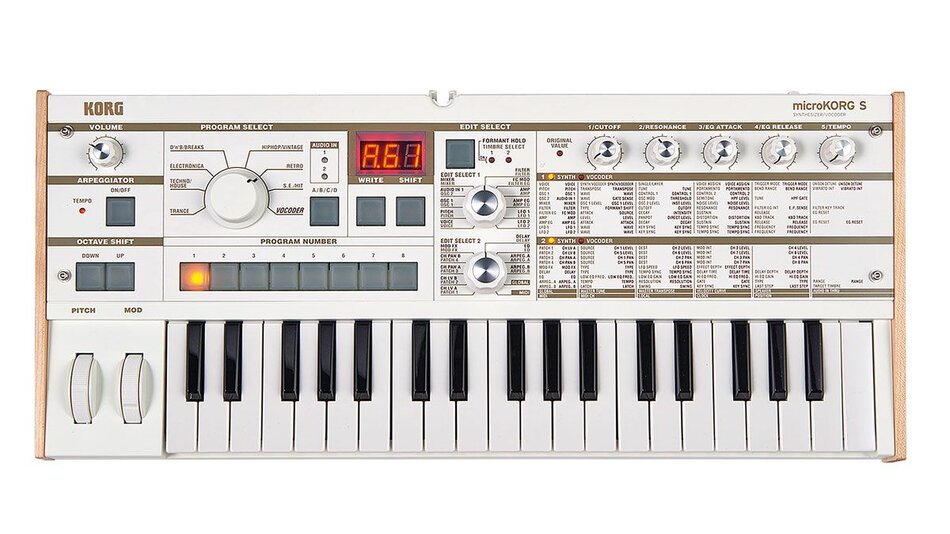
The Korg microKORG S is one of the few synths I enjoy playing a lot. And it’s my top pick for a couple of reasons we are going to get to in a bit.
The microKORG S is a successor to the original Korg MicroKorg, which was released in 2002. This mini synth was a massive success for Korg, and almost every synth enthusiast had one in the studio or for live use.
The microKORG S has the architecture and sound of the original microKORG but with some major upgrades. Speaking of upgrades, let me first talk about the new features in the microKORG S.
There are 3 built-in speakers inside microKORG S. Two of the speakers are a stereo pair, which helps capture stereo presets such as pads in an excellent way. The third speaker is a subwoofer.
This means, unlike the other synths we have discussed, the microKorg S speakers provide more low-end to “beef-up” the sound and make it much enjoyable to listen to. Undoubtedly, the three speaker system in this synth is one of the best built-in speaker systems you will find in a synthesizer. The speakers are definitely one of the reasons why this is my top pick.
The original microKORG had 128 factory programs (presets), which have been used in many records. Most of them also served as an inspiration for creating our own presets. The MicroKORG S comes with 64 additional patches. These are modern-day patches suitable for different types of genres. This means the MicroKORG S comes with 192 factory programs (presets)
Another hurdle most musicians had with the original MicroKORG was that they had to overwrite the factory program anytime they decided to tweak them and save it for later. That’s because there was no available space to save our custom presets.
Korg heard our cry. And now, in the microKORG S, there are 64 free slots to save our own patches. This means you don’t have to overwrite your favorite factory program anymore. Thank you, Korg!
Another excellent feature on the Korg MicroKORG S is the Favorites. This feature allows you to save 8 of your presets, one per each button, for faster recall. This is particularly helpful during a live performance. You can switch from one preset to another with a push of a button. I wish every synth had this feature, though.
These are the major upgrades that differentiate the original Korg MicroKORG from the new microKORG S. The synth engine is similar. However, let me briefly walk you through some of the synth’s features if you are already not familiar.
There is a built-in arpeggiator in the microKORG S with six different arpeggiator options to choose from. You can adjust note lengths and resolution of the arp notes to find something that works for you.
One thing that made the microKORG a massive success is the built-in vocoder. The synth comes with its own condenser mic, which is easily adjustable to any angle. This makes the vocoder easily accessible. There are a ton of vocoder presets for you to have fun with as well.
You’ll get five effects on the microKORG S — chorus/flanger, phaser, ensemble, delay, and EQ. This gives multiple ways to dramatically change your synth sound and make something unique. The effects can be used on the vocoder as well, which is a plus.
To simply preset tweaking, there are 5 main knobs for adjusting your sound in real-time. These knobs are Frequency, Resonance, EG Attack, EG Release, and Tempo. These knobs allow you to quickly make some changes to the sound.
The downside to this synth is you need to learn the manual if you really want to use it to full capacity. That’s because to fully take control of your synth presets and create your own from scratch requires some menu-diving.
I have never had an issue with this because I usually find a factory preset similar to what I’m looking for. However, to musicians who prefer more knobs and faders to program and tweak sounds fast, this synth may not be ideal for you.
You can power this synth with a 9V adapter included in the package or with 6AA batteries.
Pros
- Built-in subwoofer beefs up the sound
- 64 free slots to save sounds
- Favorites feature for faster recall of presets
- Five effects to create unique sounds
- Built-in vocoder
- Five knobs for easy tweaking
Cons
- Programming presets from scratch requires a bit of a learning curve
- 4-note polyphony is not enough
Bottom Line
The Korg MicroKORG S is an excellent upgrade of the original MicroKORG. It keeps all the things we loved about the original, with some more helpful improvements like the speakers and more presets
This MicroKORG S is great for those who simply want to turn on their synth and play nice-sounding presets. Although making your own presets from scratch will require you to learn this synth, the five knobs make it easy to edit presets and make your own.
4. Teenage Engineering OP-1
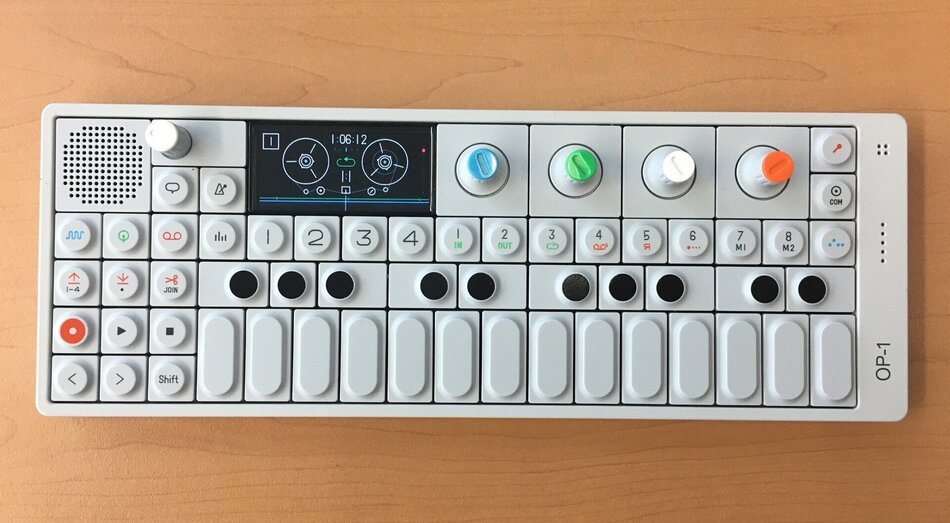
The OP-1 is arguably one of the most sought after portable synthesizers out there. It’s not just a synthesizer; it’s a full-fledged hardware digital audio workstation, I must say. That’s because it has everything you need to make a full song. This device can be a synthesizer, a sequencer, sampler, a drum machine, and a recorder — all packed in a single device.
There are many features packed into this tiny little box; I may not be able to talk about the specifics. However, the general overview should be good enough to get you up to speed on what the OP-1 can do.
Let’s talk about the Synth Engines of the OP-1. There are 10 synth engines in total in this device. Think of the synth engines as an individual synth or plugins in your DAW
Each of these engines has its own characteristics and uniqueness. Having 10 different synths in this one device gives you a lot of options to play with. Meaning, you can get some very unique sounds from it.
Also, every engine comes with its own set of presets that you can use right out of the box or tweak and make it your own. The number of ways you can tweak and edit sounds is just amazing and so much fun.
In any instance, you can load up to eight different presets from any of the engines. This will be the instruments you’ll be using for a song.
And then there is the Drum Engine. The OP-1 comes with its own drum samples, but you can load your own samples in this device and tweak it, add effects, change how it’s played back, and a lot more. Also, there is a unique drum synth in the OP-1 called DBox. It comes with its own presets but can be fun tweaking and making your own percussion sounds.
Similarly, you can load up to eight different drum engines with different samples and use them in a song.
The built-in sequencer and arpeggiator give you multiple ways to program synths and drums in a fun way. And there is the four-track tape recorder that you can use to put together a full song on the OP-1, with onboard audio effects to mix and sculpt your sounds.
There is also a built-in microphone that you can use to sample audio and edit in the sampler engine.
Obviously, I’m barely scratching the surface on what the OP-1 can do. As I mentioned earlier, it’s more than a synthesizer; it’s a digital audio workstation in small hardware. Trust me; you’re going to have a ton of fun using this device.
Let’s talk about the built-in speaker of the OP-1. To be honest, the speakers are not that great. The speakers were not made to provide you with the best experience possible. That’s because the manufacturer knows most people will use headphones or a studio monitor when making music anyway.
For this reason, the OP-1 speakers are good for jamming and making beats on the road, at the park, or in situations where you don’t want to use headphones. They are great for referencing what you are doing on the OP-1, but they don’t give you the best representation.
Pros
- 10 Synth Engines gives you a ton of sound options
- Drum engine to design percussion sound for your beats
- Different sequencer and arpeggiator modes mean you’ll never run out of ideas
- Onboard audio sampler with a built-in microphone
- Audio effects to help you create unique sounds
- Four-track tape recorder to get your ideas out fast
- Can fit in a backpack
Cons
- It’s expensive
- Only four tracks to record
- You can only work on one song at a time (you can’t save projects on the OP-1)
Bottom Line
The OP-1 is in a class of its own. It’s capable of doing a lot more than all of the synths on this list. If you are looking for a traditional synthesizer, this is not the option for you.
However, the OP-1 and its features will give you so many sound options, and it can take a lifetime to master this instrument. Also, there is a whole community on this particular synth, where you can share ideas with other OP-1 users and more.
Overall, this is an excellent instrument for any synth lover, whether a hobbyist or professional.
5. Roland Jupiter Xm
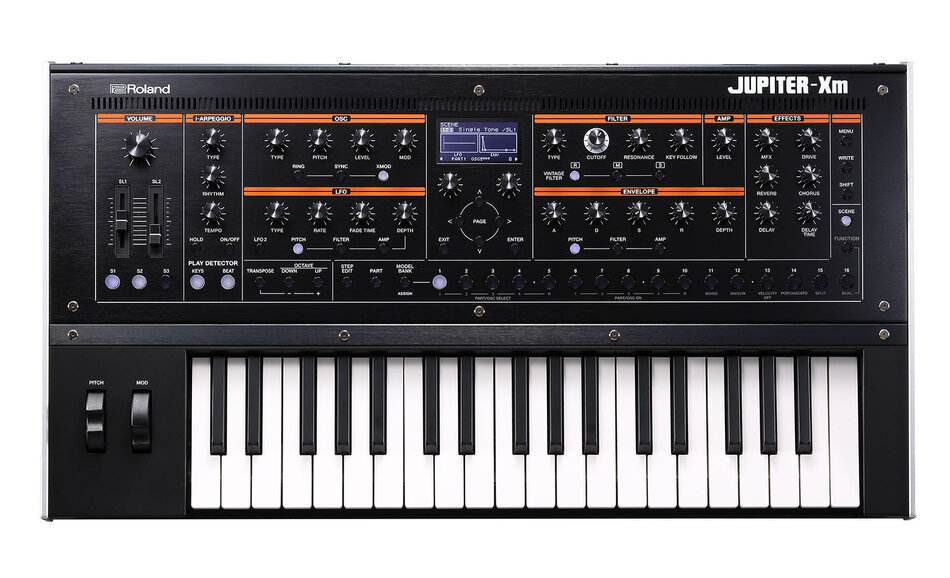
If you are looking for a well-built, very capable synthesizer with a built-in speaker, Roland Jupiter Xm is an excellent option. This is my number 2 pick for several reasons, and I’m going to share that with you.
If you are a Roland fanboy, this may actually be the only synthesizer you need. Why do I say this?
The Roland Jupiter Xm was made based on Roland’s new synthesizer technology known as the Zen-Core technology. This technology has made it possible for Roland to model some of their famous analog synthesizers and drum machines into the Jupiter Xm.
Right out of the box, there are six preloaded synthesizer models on the Jupiter Xm, and they are Jupiter 8, Juno 106, JX-8P, SH-101, XV-5080, and the new RD pianos. Each preloaded model comes with hundreds of presets to play and tweak. So there are literally 1000’s of presets that come right out of the box to play and enjoy.
Also included in the Jupiter Xm are classic drum machines such as the TR-808, TR-909, and the CR-78, all modeled using the Zen Core Technology.
One cool thing about the Jupiter Xm is you can layer and split the keyboard with up to five patches into scenes from different engines. And you don’t even have to worry about polyphony because it has a ton. This gives you the ability to create massive and lush synth sounds.
And you don’t even need to worry about space because there is a ton of internal space to store your custom patches and scenes. You can also export them to your computer for backup or send it to a friend who owns a Zen-Core compatible keyboard.
The library of sounds on the Jupiter Xm keeps expanding because there is a community of synth programmers and sound designers making sounds for Zen-Core Technology. So even if you are not an excellent synth programmer, you will always find presets made by experts online to download
Now lets talk about hands-on controls for those who love to edit sounds. There is an Oscillator section, a filter section with different filter types, an envelope section for controlling pitch, filter, and amp, an LFO section with two built-in LFOs for modulating the pitch, amp, and filter.
All these controls have dedicated very responsive knobs. That makes sound tweaking fast and flexible. Also, anything you are changing gets displayed on the Jupiter Xm’s backlit screen, making it easy to dial in the exact amount of change you want.
The Effects Section also gives you quick controls to popular effects such as Reverb, Chorus, Delay, and Drive. However, there are a total of 90 digital effects in the Jupiter Xm. That’s quite a lot of effects than you will ever need (unless you are a power user)
And then, there is the Intelligent Arpeggiator section that can add complementary drum patterns, bass lines, or chords while you play.
A lot of people don’t know this, but the Jupiter Xm also has a built-in Vocoder. It has a Combo jack input, which you can connect an XLR mic and use for the vocoder.
Let’s talk about the speakers on the Jupiter Xm — they sound really good. The speakers sound crisp and clear, without any sign of distortion. It can produce the mid and low frequencies of your synth presets to make it sound full and lush. The sound quality is not close to studio monitors, but they are way better and much more enjoyable than most of the built-in synthesizer speakers we have already discussed.
You can also connect this synth to your favorite Bluetooth speaker and play with very low latency.
Because the Jupiter Xm is Bluetooth-enabled, you can connect to your iPad, phone, or computer wirelessly using Bluetooth and use it as a MIDI controller. How cool is that! With this device, you don’t need a lightning to USB adapter to connect a midi controller to your iPad. This is really convenient.
One last thing is, you can power it with batteries when you are on the road or in a location where there is no power supply. The batteries will give you 4 hours of playing time, which I think is OK, I guess. I wish I could get more hours using batteries, though.
Pros
- Up to 9 synth and drum machine engines come right out of the box
- Built-in vocoder
- The speakers sound better than most synths with built-in speakers
- Bluetooth-enabled
- Very intuitive and easy to use
Cons
- It’s expensive
- Requires a bit of a learning curve to master this synth
Bottom Line
The Roland Jupiter Xm is a great piece of gear, I must say. There are so many presets on this synthesizer, it will take you a while to explore it all. And the library keeps expanding.
It’s a great piece of gear for live performance and the studio because it’s very well built with many features we have already discussed. If you are a professional musician, this will be a great arsenal in your toolbox.
Conclusion
Ultimately, you want a synth that is just right for your budget and has what you’re looking for in a synthesizer.
All the synths on the list are very capable synthesizer, but my no. 1 pick is the Korg MicroKORG S for how easy it is to use and the built-in speaker. My no. 2 pick is the Roland Jupiter Xm because it’s a versatile synthesizer and has loads of presets to choose from.

Hi, I’m Raymond. A keyboard player, music producer, and writer. And I’m also the founder of this blog. As someone who has been working with several audio and music equipment and different musicians for many years, my goal is to answer all your questions on music and equipment, as well as the latest music software and technology. For more info, check out my about me page
